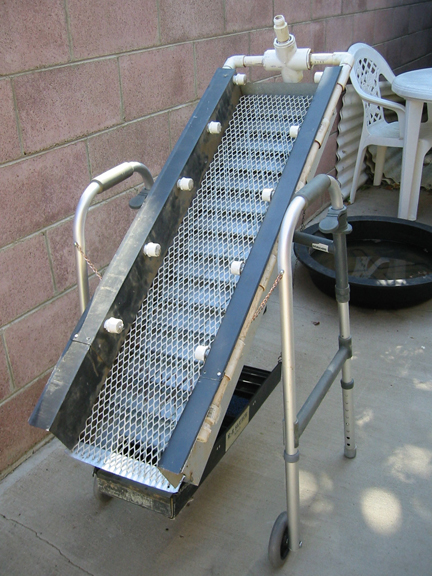Recirculating Sluice System Evolution
First mistake
My first recirculating sluice was made from metal on a 2x4" base with a collapsible frame. The base was heavy and I needed the lumber, so I replaced the frame with a walker ($5):
The nozzles were threaded 3/4" PVC caps, and the metal was heavy and sharp. It ran on a 110 VAC sump pump driven with a 1000 W inverter connected to my van battery. When the 110 VAC pump disappeared, I decided to make the system 12 VDC. I had some difficulty finding a DC pump that performed as well as the VAC pump. The one I found did not have the advertised performance, so I had to lower the separator and improve the flow.
I built a new separator from PVC gutters. The Lowe's in Lancaster did not have all the fittings with which I was familiar at the Lowe's in Clackamus, Oregon, because it rains a lot less in Lancaster than Portland. There was no center downspout for the symmetric gutter, so I had to use the asymmetric scallop-shaped gutter. I cut two 42" lengths from the 120" gutter, put caps on one end and glued them together.
I traced the resulting gutter pair end onto the flat side of the center downspout, and cut the center downspout to accommodate the gutter pair. I capped the center downspout and cut pieces from gutter scraps to cover the ends of the downspout.
I belatedly discovered that the vinyl adhesive for sale at the gutter display was unnecessary. Regular PVC glue works better and dries many times faster. The expensive vinyl adhesive is really only useful for sealing poorly fitting parts, and a cheaper caulk-adhesive would work better.
I initially used some old pool vacuum hose I had for siphon dredging to eliminate all 90-degree fittings by looping it around the separator. I went to great effort to cut and affix blind nuts to the inside ends of edges of end caps cut from the cap so they could be adhered to the sides of the gutters to provide a strong attachment point for plastic 1-1/4" U-clamps to hold the hose in place. To keep the hose perfectly parallel with the gutters, I even cut a PVC elbow in half and bonded it to the hose at the top of the separator. I stuck drip sprayers and couplers in the hose to spray the separation area.
Too many fittings would be required to provide the needed flow rate, and they would likely plug with organic material, so I replaced the separator part of the hose with 1-1/4" PVC pipe. I cut the pump hose to 4' and glued it in a PVC elbow connected to the PVC pipe. I cut 5' from the other end to provide a hose for washing the separator into the sluice, and flushing the sluice before emptying it into a pan for final separation.
So I replaced the metal with PVC.
| W. T. Holmes | Prospecting | Original Metal System | First PVC System | First Field Test | Second Field Test | Updates |
